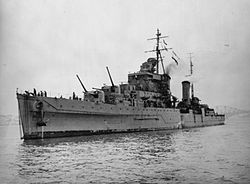HMS Dido (37)
|
||||||||||||||||||||||
|
||||||||||||||||||||||
|
||||||||||||||||||||||
|
||||||||||||||||||||||
The HMS Dido was a light cruiser of Dido class of the British Royal Navy and during the Second World War in use. Although the Dido gave the class its name, it was only launched as the sixth ship of the class on July 15, 1939, and then came into service with the Royal Navy on September 30, 1940 as the third ship of the class together with the sister ship Phoebe .
The Dido was mostly used in the Mediterranean during the war and earned ten battle honors . At the end of the war, after the German surrender in May 1945, she escorted the remaining German cruisers ( Prinz Eugen and Nürnberg ) from Copenhagen to Wilhelmshaven .
The refurbished cruiser had been in reserve since 1947. From 1952 to 1956 the Dido was the flagship of the reserve fleet in Portsmouth without returning to active service. In July 1956 the demolition of the cruiser began.
construction
The Dido was built at the Cammell Laird shipyard in Birkenhead .
Calls
Second World War
After commissioning at the beginning of November 1940, the Dido was sent with the 15th cruiser flotilla on a blockade mission to the Biscay to prevent attacks by the German armored ship Admiral Scheer . In March 1941 she secured a successful commando operation in Lofoten ( Operation Claymore ).
Mediterranean Sea
In April 1941, the Dido was assigned to the Mediterranean to reinforce the naval base in Alexandria . In May she accompanied convoys from Alexandria to Malta . On the 29th of the month, the Dido and the cruiser HMS Orion were badly damaged by German bombs after they had taken troops on board at Sfakia and Heraklion during the British retreat from Crete . In June she was assigned to the forces of Rear Admiral Halifax, who were to take the port of Assab in what is now Eritrea .
In July 1941 the cruiser was in the docks of Simonstown and the port of Durban in South Africa for repairs . On August 15, he set course for the USA, where he was refitted in the Brooklyn Navy Yard . In December 1941 the Dido was back in the Mediterranean and resumed her duties as protection for the Malta convoys .
Various missions in the Mediterranean followed by April 1943. The Dido then went back to the UK to undergo urgently needed repairs and re-equipment. In addition to strengthening the anti-aircraft armament, the 102 mm gun was replaced by a fifth 133 mm twin turret. From July she was back and supported the Allied invasion of Sicily ( Operation Husky ) until September .
Arctic
In October 1944, the Dido was sent to the Arctic Ocean to escort northern sea convoys to the Soviet Union. During November, she took over the protection of the aircraft carrier Implacable during an attack on a German convoy. After the German surrender in May 1945, she escorted the German cruisers Prinz Eugen and Nürnberg from Copenhagen to Wilhelmshaven .
post war period
From March to August 1946, the Dido received its final modernization, keeping its fifth 133mm twin tower. Although still quite modern, this class of cruiser was considered too cramped and unstable to be fundamentally modernized. In September she was assigned to the 2nd cruiser flotilla after the work was completed. In October 1947 she was stationed as a reserve in Gare Loch and transferred to the reserve fleet in Portsmouth in 1951 . In November 1956, the Dido and her sister ship HMS Cleopatra , which had served as flagships of the reserve fleet up to this point, were replaced by the battleship HMS Vanguard .
Whereabouts
From July 16, 1956, Dido was finally replaced by Thomas W. Ward Ltd. scrapped in Barrow-in-Furness , Cumbria , England.
literature
- Roger Chesneau (Ed.): Conway's All the World's Fighting Ships. 1922-1946. Conway Maritime Press, London 1980, ISBN 0-85177-146-7 .
- James J. Colledge, Ben Warlow: Ships of the Royal Navy. The complete record of all Fighting Ships of the Royal Navy from the 15th century to the present. New revised edition. Chatham, London 2006, ISBN 1-86176-281-X .
- Bernard Ireland: The Illustrated Guide to Cruisers. Hermes House, London 2008, ISBN 978-1-84681-150-0 .
- Alan Raven, H. Trevor Lenton: DIDO class Cruisers (= Ensign. 2). Bivouac books, London 1973, ISBN 0-85680-003-1 .
- Ben Warlow: Battle Honors of the Royal Navy. Maritime Books, Liskeard 2004, ISBN 1-904459-05-6 .
